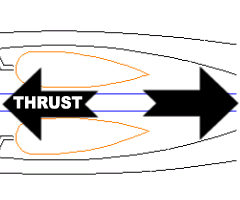Jet propulsion
I’ve grudgingly included this section by popular request. Rocket and turbojet engines are fabulous technological achievements—but they’re so simple that the animations are boring!
At least I think so. You be the judge!
Rocket

The rocket engine is the simplest of this family, so we’ll start there.
In order to work in outer space, rocket engines must carry their own supply of oxygen as well as fuel. The mixture is injected into the combustion chamber where it burns continuously. The high-pressure gas escapes through the nozzle, causing thrust in the opposite direction.
To test this principle yourself, inflate a toy balloon and release it without tying it off…rocket propulsion at its simplest.
Turbojet
The turbojet employs the same principle as the rocket, except that it burns oxygen from the atmosphere instead of carrying its own supply.

Notice the similarities: Fuel continuously burns inside a combustion chamber just like the rocket. The expanding gasses escape out the nozzle generating thrust in the opposite direction.

Now the differences: On its way out the nozzle, some of the gas pressure is used to drive a turbine. A turbine is a series of rotors or fans connected to a single shaft. Between each pair of rotors is a stator, which is something like a stationary fan. The stators realign the gas flow to more effectively direct it toward the blades of the next rotor.

At the front of the engine, the turbine shaft drives a compressor. The compressor works a lot like the turbine only in reverse. Its purpose is to draw air into the engine and pressurize it.
Turbojet engines are most efficient at high altitudes, where the thin air renders propellers almost useless.
Turboprop
The turboprop is similar to the turbojet, except that most of the nozzle gas pressure drives the turbine shaft—by the time the gas gets past the turbine, there’s very little pressure left to create thrust.
Instead, the shaft drives a a propeller that creates the majority of the thrust. A gear train is employed to turn the propeller at a slower speed than turbine shaft. Jet helicopters work the same way, except that their engines are connected to the main rotor shaft instead of a propeller.
Turboprops are more fuel efficient than turbojets at low altitudes, where the thicker air gives a propeller a lot more traction. This makes them popular on planes used for short flights, where the time spent at low altitudes represents a greater percentage of the overall flight time.
Turbofan
The turbofan is something like a compromise between a pure turbojet and a turboprop. It works like the turbojet, except that the turbine shaft also drives an external fan, usually located at the front of the engine.
The fan has more blades than a propeller and spins much faster. It also features a shroud around its perimeter, which helps to capture and focus the air flowing through it. These features enable the fan to generate thrust at high altitudes, where a conventional propeller would be ineffective.
Some of the thrust still comes from the exhaust jet, but the addition of the fan makes the engine much more fuel efficient.
The ratio of air passing through the fan to air passing through the engine core is known as the bypass ratio. Most modern jetliners feature fairly high bypass ratios, and thus derive more of their thrust from the fan than the exhaust jet.
As you can see, all of these engines are conceptually very simple, and have very few moving parts, making them extremely reliable. They also have an excellent power-to-weight ratio, which is partly why they’re so popular in aircraft.
Like most of my illustrations, these are extremely simplified. Turbine engines often employ more than one shaft and have other more complex features that I really don’t understand and, frankly, don’t care to investigate further.
For some terrific illustrations and a lot more information on these engines, see the NASA website: http://www.grc.nasa.gov/WWW/K-12/airplane/shortp.html
Now, don’t you think the other engines are a lot more fun?

 Follow
Follow Befriend
Befriend Subscribe
Subscribe